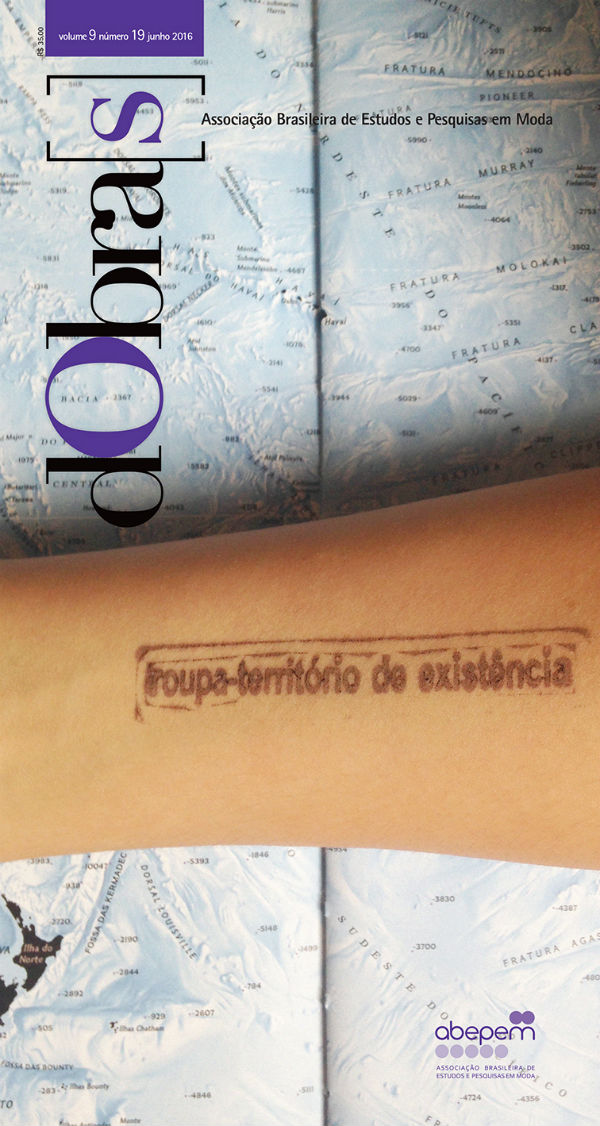Reflexões sobre a inerência do corpo, do estilo de vida e da identidade no design de moda-vestuário
DOI:
https://doi.org/10.26563/dobras.v9i19.453Palavras-chave:
indicadores de consumo, gestão do design, tomada de decisão.Resumo
Os métodos e técnicas para o desenvolvimento de produtos de moda-vestuário precisam incluir elementos tangíveis e intangíveis, sob pena de se distanciar das reais expectativas dos consumidores. Neste estudo, propõe-se a reflexão de três dimensões essenciais – a identidade, o estilo de vida e a condição corpórea – por meio dos indicadores para o consumo de roupas. Nesse sentido, apresenta-se o modelo CEvI, no intuito de reduzir o número de variáveis a se considerar no design, sem perder precisão no que tange ao levantamento de necessidades e alternativas.
Downloads
Referências
ABERNATHY, F.; DUNLOP, J. T.; HAMMOND, J. & WEIL, D. A Stitch in Time. Oxford: Oxford University Press, 1999. DOI: https://doi.org/10.1093/oso/9780195126150.001.0001
BLACKWELL, R.; ENGEL, J. F. & MINIARD, P. W. Consumer Behaviour. Chicago: The Dryden Press, 2002.
CANADA. Gender-Based Analysis+. Status of Women Canada, 2013. Disponível em: <http://www.swccfc.gc.ca/pol/gba-acs/index-eng.html>. Acesso em: 20 mar. 2013.
COOPER, R. & PRESS, M. The Design Agenda: a guide to successful design management. Chichester: Wiley, 1995.
FLÜGEL, J. C. A psicologia das roupas. São Paulo: Editora Mestre Jou, 1966.
FRISBY, D.; FEATHERSTONE, M. Simmel on Culture. London: Sage, 1997.
HENLEY CENTRE. Economic Forecasting Report. London: The Henley Centre, 2002.
ILTANEN, S. Ageless and Ageing: a survey of fashion designers and their conceptions of the target group. In: Include 2003 Conference. Proceedings of Include 2003 Conference. London, Royal College of Art, p.356-361, 2003.
ILTANEN, S. Constructing the image of a user through design. In: Proceedings of Include 2005 Conference, London, Royal College of Art, 2005.
JORDAN, P. W. Designing Pleasurable Products: an introduction to the new human factors. London: Taylor & Francis, 2000. DOI: https://doi.org/10.1201/9780203305683
KAWAMURA, Y. Fashion-ology. Oxford: Berg, 2005. DOI: https://doi.org/10.2752/9781847888730
LI, Z. Functional clothing design for the active grey market. In: Include 2003 Conference. Proceedings of Include 2003 Conference. London, Royal College of Art, p. 346-355, 2003.
LIN, Y.-T.; XIA, K.-N. Cognitive age and fashion consumption. International Journal of Consumer Studies, n. 36, p. 97-105, 2012. DOI: https://doi.org/10.1111/j.1470-6431.2010.00991.x
LIPOVETSKY, G. A felicidade paradoxal: ensaio sobre a sociedade de hiperconsumo. São Paulo: Companhia das Letras, 2007.
MASLOW, A. H. Motivation and Personality. New York: Harper Collins Publishers, 1987.
McCRACKEN, G. Culture and Consumption: A theoretical account of the structure and movement of the cultural meaning of consumer Goods. Journal of Consumer Research, v. 13, p. 71-84, 1986. DOI: https://doi.org/10.1086/209048
NAM, J.; HAMLIN, R.; GAM, H. J.; KANG, J. H.; KIM, J.; KUMPHAI, P.; STARR, C. and RICHARDS, L. The fashion-conscious behaviours of mature female consumers. International Journal of Consumer Studies, 31:102–108, 2000. DOI: https://doi.org/10.1111/j.1470-6431.2006.00497.x
POPCORN, F. , MARIGOLD, L. Click: 16 tendências que irão transformar sua vida, seu trabalho e seus negócios no futuro. Tradução de Ana Gibson. Rio de Janeiro: Campus, 1997.
ROCHA, M. A. V.; HAMMOND, L. & HAWKINS, D. Age, Gender and National Factors in Fashion Consumption. Journal of Fashion Marketing and Management, v. 9, ed. 4, p. 380-390, 2005. DOI: https://doi.org/10.1108/13612020510620768
ROCHA, M. A. V. Study of Consumer Clothing Behaviour and its Relevance to Successful Fashion
Product Development. Thesis (PhD in Fashion Design). University College for the Creative Arts/University of Kent, United Kingdom. 2007.
SIMMEL, G. The Philosophy of Fashion. In: FRISBY, D. & FEATHERSTONE, M. (ed.) Simmel on Culture. London: Sage, 1997.
SOLOMON, M. & RABOLT, N. J. Consumer Behaviour in Fashion. Upper Saddle River, NJ: Prentice Hall, 2004.
SOLOMON, M. R. Consumer Behaviour: buying, having and being. Upper Saddle River, New Jersey: Prentice Hall, 1998.
WACOAL. Spiral Ageing. The Human Research Center, 2000. Disponível em: <http://www.wacoal.ph/mvc/page/p-4: Acesso em: 20 mar. 2013.
ZHANG, Z; LI, Y; GONG, C; WU, H. Casual wear product attributes: a Chinese consumers perspective. Journal of Fashion Marketing and Management, v. 6 n. 1, p. 53-62, 2002. DOI: https://doi.org/10.1108/13612020210422464










